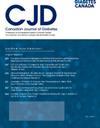Glycemic Management in Diabetic Foot Ulcers: A Comparative Analysis of Wound and Wound-free Periods in Adults With Type 1 and Type 2 Diabetes
IF 2.3
4区 医学
Q3 ENDOCRINOLOGY & METABOLISM
引用次数: 0
Abstract
Objective
Our aim in this study was to determine whether there are differences in glycemia during wound and wound-free states among individuals with diabetes at a multidisciplinary diabetic foot and wound clinic from 2012 to 2019.
Methods
We conducted a retrospective analysis of prospectively collected data over 7.4 years from the Johns Hopkins Multidisciplinary Diabetic Foot and Wound Clinic. Participants with diabetic foot ulcers were observed during at least one wound period and one wound-free period and had at least one glycated hemoglobin (A1C) measurement in both a wound period and a wound-free period. The A1C measurements were aggregated and summarized across wound and wound-free periods, and compared using the Wilcoxon matched-pairs signed rank test.
Results
Two hundred six eligible participants with a total of 623 wounds were included in this analysis. Participants were followed for a median period of 2.4 years (876 days). There were no significant differences in mean, minimum, and maximum A1C between the aggregate wound and wound-free periods, with median values of 7.6% (interquartile range [IQR] 6.6% to 9.1%) and 7.5% (IQR 6.6% to 9.1%) for mean A1C (p=0.43), 6.9% (IQR 6.0% to 8.0%) and 6.8% (6.0% to 8.1%) for minimum A1C (p=0.78), and 8.6% (IQR 7.1% to 10.9%) and 8.5% (IQR 7.0% to 10.7%) for maximum A1C (p=0.06) in the wound and wound-free periods, respectively.
Conclusions
This retrospective study shows similar levels of A1C during wound and wound-free periods; however, given the limitations of missing A1C and small sample size, further studies leveraging continuous glucose monitoring are needed to determine whether glycemia worsens in the setting of a DFU.
糖尿病足溃疡的血糖控制:1 型和 2 型糖尿病成人患者伤口和无伤口期的比较分析。
目的:确定 2012-2019 年期间在多学科糖尿病足和伤口诊所就诊的糖尿病患者在伤口和无伤口状态下的血糖是否存在差异:我们对约翰霍普金斯大学多学科糖尿病足和伤口诊所 7.4 年来的前瞻性数据进行了回顾性分析。对患有糖尿病足溃疡(DFU)的参与者进行了至少一次伤口期和一次无伤口期的观察,并在伤口期和无伤口期进行了至少一次血红蛋白 A1C(A1C)测量。结果:206 名符合条件的参与者共 623 处伤口被纳入本次分析。参与者的随访时间中位数为 2.4 年(876 天)。总伤口期和无伤口期的平均、最低和最高 A1C 没有明显差异,平均 A1C 的中位数(四分位间 [IQR])值分别为 7.6% (6.6%, 9.1%) 和 7.5% (6.6%, 9. 1%) (见表 2)。平均 A1C 值为 7.6% (6.6%, 9.1%) 和 7.5% (6.6%, 9.1%) (p = 0.43),最低 A1C 值为 6.9% (6.0%, 8.0%) 和 6.8% (6.0%, 8.1%) (p = 0.78),最大 A1C 值为 8.6% (7.1%, 10.9%) 和 8.5% (7.0%, 10.7%) (p = 0.06):这项回顾性研究显示,伤口期和无伤口期的 A1C 水平相似,但鉴于 A1C 缺失和样本量较小的局限性,需要利用连续血糖监测 (CGM) 数据开展进一步研究,以了解 DFU 是否会导致血糖恶化。
本文章由计算机程序翻译,如有差异,请以英文原文为准。
求助全文
约1分钟内获得全文
求助全文
来源期刊

Canadian Journal of Diabetes
ENDOCRINOLOGY & METABOLISM-
CiteScore
4.80
自引率
4.00%
发文量
130
审稿时长
54 days
期刊介绍:
The Canadian Journal of Diabetes is Canada''s only diabetes-oriented, peer-reviewed, interdisciplinary journal for diabetes health-care professionals.
Published bimonthly, the Canadian Journal of Diabetes contains original articles; reviews; case reports; shorter articles such as Perspectives in Practice, Practical Diabetes and Innovations in Diabetes Care; Diabetes Dilemmas and Letters to the Editor.
 求助内容:
求助内容: 应助结果提醒方式:
应助结果提醒方式:


